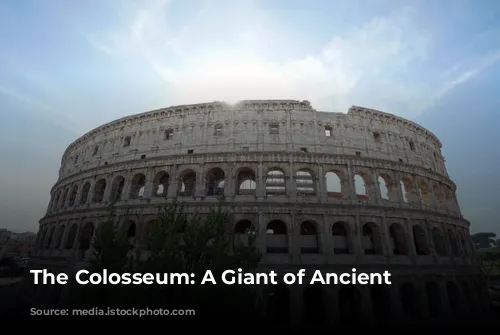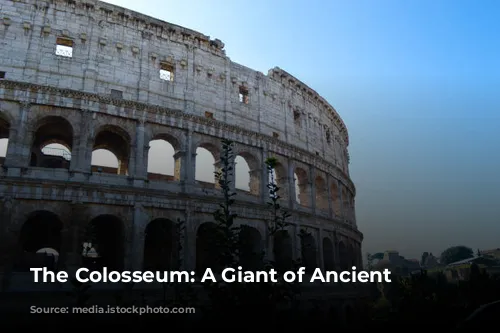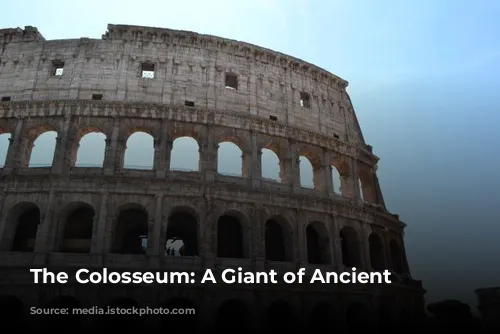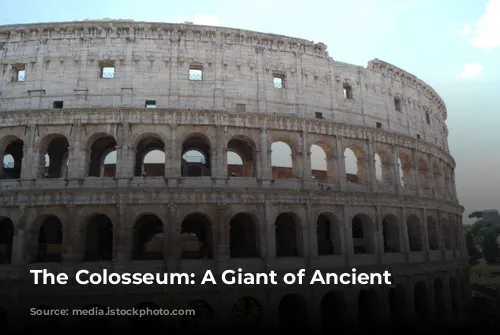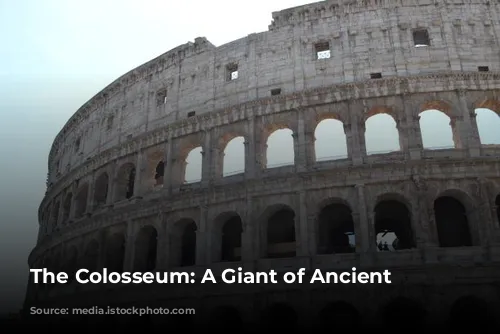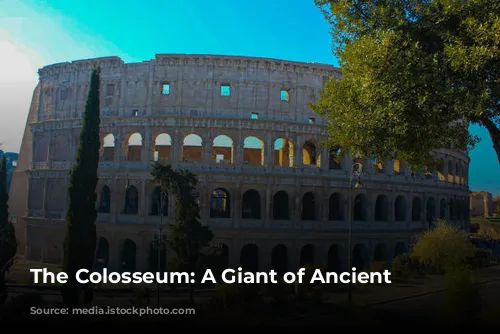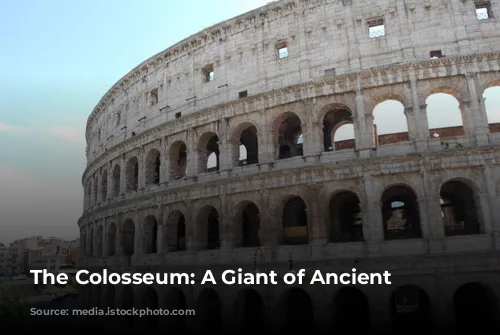The Colosseum, also known as the Flavian Amphitheatre, is a towering testament to the grandeur of the Roman Empire. It’s not only the largest amphitheatre in the Roman world but also a symbol of Rome itself, attracting visitors from across the globe. This magnificent structure was a labor of love for the Flavian dynasty, with Emperor Vespasian laying the foundation and his son Titus officially opening it in 80 AD.
A Grand Opening
The Colosseum’s inauguration was an extravagant spectacle lasting one hundred days! The crowds were treated to an incredible array of gladiatorial combats, animal hunts, and breathtaking shows, including the naumachia – staged sea battles that recreated historical naval clashes. The sheer scale of these events is astounding, with historians claiming that over 5,000 animals were slaughtered during the opening ceremonies alone.
The “Colosseum” Name
You might be wondering why this incredible structure is called the “Colosseum”. The name first appears in a famous prophecy by Venerable Bede, a medieval monk. He predicted: “Rome will exist as long as the Colosseum does; when the Colosseum falls so will Rome; when Rome falls so will the world.” Some believe that Bede may have drawn inspiration from the Colossus of Nero, a gigantic statue of the emperor that stood near the amphitheatre. This statue, towering at 35 meters, was destroyed long ago, leaving only the name and a hint of its imposing presence.
An Architectural Marvel
The Roman Colosseum is a remarkable feat of engineering. Imagine this massive structure, originally gleaming white, entirely covered in stunning travertine stone slabs. Its elliptical shape, designed to hold a greater number of spectators, is truly awe-inspiring. The Colosseum was comprised of four levels, each with its own architectural character. The first three floors boasted 80 arches each, with the second and third adorned with colossal statues.
The Romans were masters of the arch, a technique that allowed them to distribute the weight of their massive structures effectively. Their mastery of the arch is evident in their aqueducts and other architectural wonders. You could almost say the Colosseum is a series of aqueducts stacked one on top of the other!
Time Takes Its Toll
While the Colosseum stands as a testament to Roman ingenuity, time has taken its toll. Today, we only see the skeletal remains of the once-glorious arena. Almost two-thirds of the outer brick wall is missing, a consequence of centuries of looting and neglect. During the Middle Ages, the Colosseum was transformed into a quarry, its marble, lead, and iron plundered to build grand palaces and even St. Peter’s Basilica.
The holes in many of the columns are a chilling reminder of this past, evidence of the extraction of iron and lead for building materials.
A Seat for Every Citizen
The Colosseum could accommodate a staggering 70,000 spectators, a testament to the Romans’ passion for public spectacles. The seating arrangement was ingeniously designed, with tiers of seats inclined to ensure perfect views for all. Entry was free for Roman citizens, but their seats were determined by their social status, much like today’s theaters. The common people occupied the upper tiers, while senators, priests, and the Emperor held court in the front row.
Just like modern sports stadiums, the Colosseum had a clever solution to protect its audience from the sun. The Velarium, a massive linen awning, was stretched over the arena using a complex system of ropes, winches, and wooden poles. One hundred sailors from the Imperial fleet were needed to maneuver this massive canopy, their synchronized movements coordinated to the beat of a drum.
The Arena’s Secrets
Stepping inside the Colosseum, you are greeted by the remains of the arena itself, the stage for the various spectacles. The once-sturdy floor, a mixture of brick and wood, has vanished, revealing the underground cellars that housed the equipment used to prepare for the games. These cellars housed lifts and hoists, their rails still visible today. These were the special effects of their time, used to raise animals and gladiators through trapdoors, creating spectacular bursts of white dust that captivated the audience.
This ingenious system also allowed for the hoisting of elaborate backdrops, used for hunting events.
The Colosseum wasn’t just entertainment; it also served as a powerful symbol of the Emperor’s authority, uniting the people through their shared experience and providing a welcome distraction from the trials of daily life.
The Show Must Go On
The Colosseum hosted an impressive variety of events, each meticulously scheduled. Mornings were reserved for Venationes, battles between exotic animals, or between men and animals. These hunts could also serve as public executions, leaving individuals to face the mercy of ferocious beasts. The Silvae, a recreation of forests complete with trees, bushes, and animals, provided a spectacle of a different kind. These hunts did not always involve killing the animals, making them a unique form of entertainment.
Even less-violent events took place, such as the famous display of an elephant that learned to write words in the sand using its trunk.
Contrary to popular belief, the Colosseum was not used for the mass slaughter of Christians as a form of spectacle.
The Gladiators: Heroes of the Arena
The event that captivated the Roman public most was the gladiatorial combats. The roar of the crowd, the blare of trumpets, and the beat of drums reached a crescendo as the gladiators emerged from their underground passage, connected to the Ludus Magnus, their barracks. These men were welcomed like heroes, their popularity akin to that of modern sports champions.
The gladiators, whose name is derived from the gladius, the short sword used by legionaries, were not always forced into combat. Many were prisoners of war offered a choice: slavery or the chance to fight in the arena for a limited time, with the possibility of freedom and wealth. Others, driven by poverty, saw it as a path to fame and fortune. Gladiators were paid handsomely and enjoyed immense popularity, especially among women, who were known to pay exorbitant sums for a night of passion with these celebrated warriors.
There were twelve types of gladiators, each with their own unique weaponry and fighting style. Some, like the Retiarius, relied on a net, trident, and knife, while others wielded shields and sickles. The duels were carefully orchestrated, with gladiators chosen from different categories for dramatic effect.
A wounded gladiator could plead for mercy by raising an arm, a gesture that would prompt the crowd to call for the Emperor’s intervention. The Emperor held the power of life or death: a raised thumb signified mercy, while a lowered thumb meant certain death.
Victorious gladiators were showered with accolades, including gold palm leaves and substantial sums of money. After each battle, servants dressed like Charon, the ferryman of the underworld, would ensure the wounded were truly dead, putting an end to their suffering. Gladiators’ blood was highly prized, believed to have healing properties and could cure epilepsy and enhance sexual vigor.
A Brutal Spectacle
The Romans’ love for these bloody spectacles, which we consider violent, is a testament to their culture. Their passion for these events can be compared to the modern fascination with “splatter” cinema. However, the Colosseum offered a visceral experience that transcended mere entertainment. The smell of blood, burnt flesh, and wild animals permeated the air, a sensory experience that couldn’t be masked by incense or perfumes.
A Legacy of Change
After the decline of the Roman Empire, the Colosseum fell into disuse, its walls becoming a refuge for confraternities, hospitals, hermits, and even a cemetery. During the Middle Ages, the Colosseum was rediscovered as a symbol of Rome’s glorious past, captivating visitors from around the world.
Threatened with demolition by Pope Sixtus V, the Colosseum was declared a sacred monument dedicated to the Passion of Christ by Pope Benedict XIV. A cross, placed on a pedestal, symbolizes the suffering of Christian martyrs and serves as the starting point for the Stations of the Cross on Good Friday.
This gesture transformed the Colosseum into a place of worship for Christians, safeguarding it from further destruction. Subsequent Popes continued to restore and preserve this architectural wonder.
For modern travelers, a visit to the Colosseum is a journey through time, an opportunity to glimpse the “ghost of old Rome”, as Charles Dickens eloquently put it. The Colosseum stands as a powerful reminder of a lost civilization, its imposing presence a testament to the grandeur, power, and brutality of the Roman Empire.
